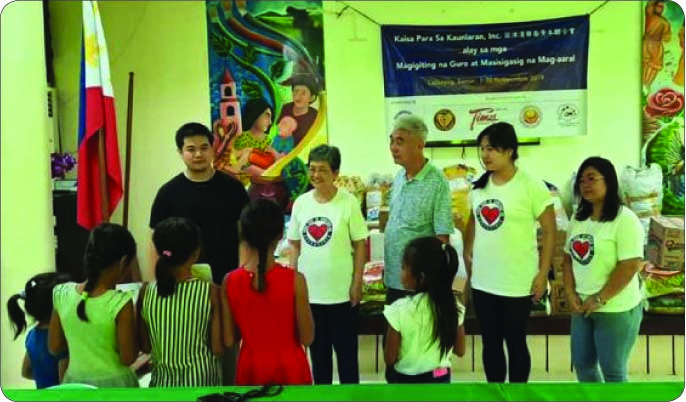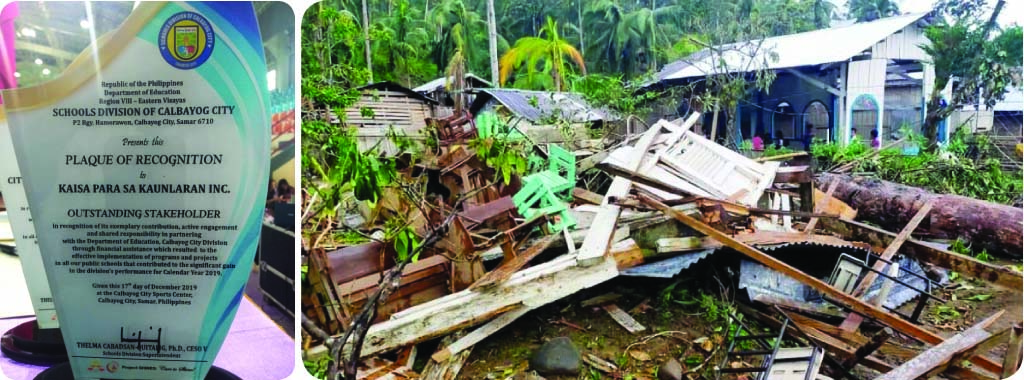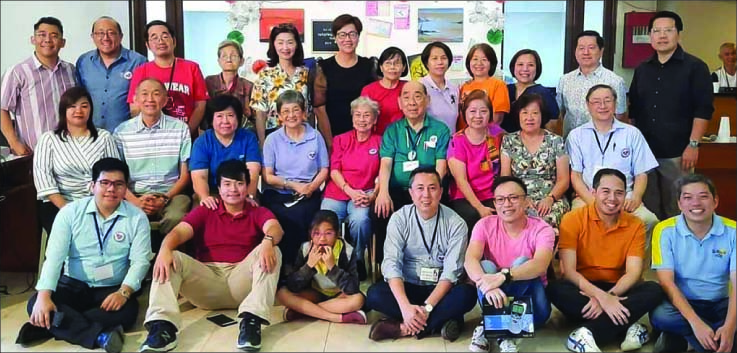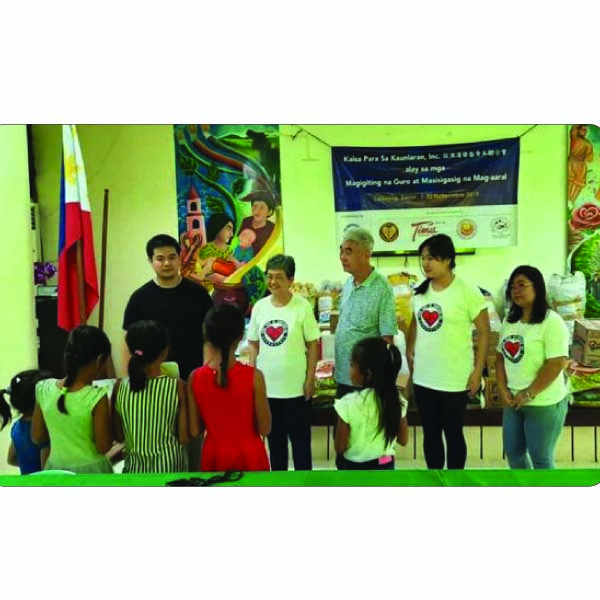
Few in Manila think of public school teachers in Calbayog, Samar.
Few in Manila think of Calbayog, Samar. Period.
Yet, these teachers face daunting challenges, as they teach children in remote local communities.
Some of them travel as much as 11 hours across rivers, mountains and rice fields to get to their students. They only get to go home once or at most twice a month.
Some live through the horrors and constant threat of armed conflicts between feuding politicians or the military and insurgents.
Some starve during the habagat season because food on the island becomes scarce and no boat would dare venture into the tempestuous waters.
Some witness 10-year-old female students being married off to any man who can afford to pay a P30,000 dowry, even by installment, just to rid the family of another mouth to feed.
Their realities became a cause for Teresita Ang See and Jover Laurio, both committed to helping those less fortunate.
Laurio is part of Team Pilipinas, a group of volunteers who wish to be part of the solution to our country’s myriad of problems.
Laurio is the blogger behind the influential political essays under Pinoy Ako Blog. She is the Philippine Daily Inquirer’s 2017 Filipinos of the Year awardee for leading the fight against fake news. She has written a series of blogs about Samar’s bayaning guro (heroic teachers).
Ang See is co-founder of Kaisa Para Sa Kaunlaran, a cause-oriented nongovernment organization that promotes integration between Tsinoys and fellow Pinoys. Kaisa’s mission is to participate fully in addressing the country’s ills and in nation building.
A mission to bring supplies to four schools in Calbayog was, therefore, planned. But an unexpected illness grounded Laurio, so I was picked to take her place, because I was her partner during an outreach project that reached out to the same recipients a couple of months back.
Before our Nov. 29 trip to Calbayog, I was told I would be the on-site documentation writer for the project.
Unfounded bias
In truth, I have to admit that I had my reservations about the trip. All my would-be companions were complete strangers to me. The only thing I knew about them was that they were all Tsinoys, a fact that did not sit well with me either.
I knew a handful of Tsinoys through my husband. But I also believed that a lot of people of Chinese descent living in the Philippines are out to enrich themselves at the expense of Pinoys like me.
I realize that many of them were born and raised here and might be Filipino citizens for far longer than I have been alive. But I believed that they consider us their slaves that will do their bidding for meager compensation, and after they eventually bleed the country dry, they would leave to look for another country to exploit.
All these notions dramatically changed after the trip to Samar.
We had a 6:50 a.m. flight to catch on Nov. 29, and I would be coming from our home in Malolos, Bulacan. Ang See offered, no, insisted that I use the extra bedroom in her house the night before our flight. She also insisted that I do the same when we get back from our return to Manila on the late-night flight.

She knew nothing about me, except that I am a volunteer for Team Pilipinas and a freelance writer for the Inquirer. Given her experience with kidnappings targeting mainly Tsinoys, one would have thought her to be extra-careful and less trusting. So, I questioned her kind and motherly gesture.
That made me think.
Then I met Andrew Tuason, Kaisa officer, and Misha Hwang, Tsinoy volunteer and fresh out of college. They started chattering right away with their “conyo” (Filipino pidgin) way about trips abroad.
They also displayed what I felt was “we-don’t-care-if-you-feel-alienated” attitude by talking as if they were on their own instead of being members of a four-person team. I used every ounce of my willpower not to roll my eyes childishly.
But, inwardly, I muttered, “There, that is their true color. This outreach is nothing but an effort for their closely-knit community’s image-building. And, like a true gullible Pinoy, you fell for it!”
Then we met Samuel Ngo, vice president of the Amity Club-Tacloban Chapter, a branch of a Manila-based Tsinoy nongovernment organization established in the 1970s. It is also one of Kaisa’s partner organizations.
He collected us from the airport, and things for me went from bad to worse. It was apparent he was neither too keen nor comfortable speaking in either English or Filipino. So they conversed constantly in Chinese.
Give it time
Time, they say, is a revealer of a person’s true nature. True enough, I got to know the four of them a lot better during the time we were all together.
I learned that the indomitable Ang See, who is now Tita Tessy to me, is not just genuinely motherly. She is also a deep well of wisdom. Whenever she speaks, everybody listens. She has a way of asserting her authority without sounding authoritative. She can be compassionate without being overly emotional. As far as her values are concerned, she is as straight as an arrow.
And never once did she display any self-entitlement tendencies despite her legendary stature. Who would forget her fearless words, “Yan naman lang ang alam niyan – publicity!” she shouted to then vice president Joseph Estrada’s face, in the presence of a battalion of reporters?
It was obvious that both Tuason and Hwang come from privileged backgrounds. But when we got to the Department of Education’s Calbayog office where the turnover of donations was to be held the next day, they readily got to work.
They sorted out goods and carried heavy boxes up the stage. I also saw how they sat the teachers down and engaged them in intimate conversations to hear their firsthand accounts of their daily struggles as teachers.
Hwang, 21, shared that she is most happy to be able to join us instead of just donating funds to the project, as her schoolmates are more likely to do when there is a call for volunteers.
Apparently noticing that I could not understand a word of Chinese, Ngo, who we fondly called Uncle Sam later on, became extra-considerate. Though clearly struggling, he started talking more in English and Filipino.
He shared with us how he purchased groceries and rice for the four schools, as contributions from Filipino Chinese Amity Club Tacloban Chapter. He also told us that he had to be up at 2:00 a.m. to finalize the distribution list, how much and what goods will go to each school.
Later, he became comfortable enough to shed his inhibitions. It was then I saw his other side, Uncle Sam is a chatterbox! He talked about anything to keep us entertained, especially during the long drive from Tacloban to Calbayog and back. From the rear view mirror, I could see how he could hardly conceal his mirth when we would slide sideways whenever he negotiated sharp curves without slowing down.
Yes, Uncle Sam, a senior citizen, could still drive like a maniac, and he enjoyed every minute of it.
Clinching the deal
There were actually three instances that convinced me my Tsinoy companions were the real deal, that they were not merely putting up a pretense or being condescending to us lesser mortals.
After learning there are teachers on Almagro island who hold classes inside churches or improvised classrooms, they convinced that school’s representatives to send a letter of request to Kaisa.
They were looking to raise funds to build at least two classrooms for them, if the Kaisa board approves the request.

With the donations handed over, the mission in Calbayog was done. But they were willing to return and do more because they saw the urgent need for classrooms. They really tried to find out what their recipients needed. They listened to the stories and sentiments of their beneficiaries, and showed genuine empathy.
We were pressed for time as we headed back to the airport. But the Kaisa delegates knew how badly I wanted to see McArthur Park in Palo, Leyte. So they indulged me.
Uncle Sam, yet again, transformed himself into a photographer and all-around tourist guide. He also showed us around his friend’s amazing 32-hectare shrimp farm.
“Lupang Hinirang” at the Kaisa party
A few days after our trip, I received an invitation from Tita Tessy to attend Kaisa’s Christmas party. When my husband and I arrived, we were immediately made to feel welcome despite our inability to understand Chinese, the language used by most of older Tsinoys there. But what really made an impression on us was when they started the program by singing our national anthem.
Imagine a bunch of people who looks very Chinese yet singing the very Filipino Lupang Hinirang. It was a sight to behold.
After the national anthem they recited their credo, every word of which gave me goosebumps:
“The Philippines is our country,
it is the land of our birth,
the home of our people.
Our blood may be Chinese
but our roots grow deep in Philippine soil,
our bonds are with the Filipino people.
We are proud of the many cultures
which have made us what we are,
it is our desire, our hope and aspiration –
that with the rest of our people,
we shall find our rightful place
in the Philippine sun.”
Right there and then, I decided to volunteer for Kaisa’s next outreach project. Yes, kaisa na ninyo ako, Kaisa!
